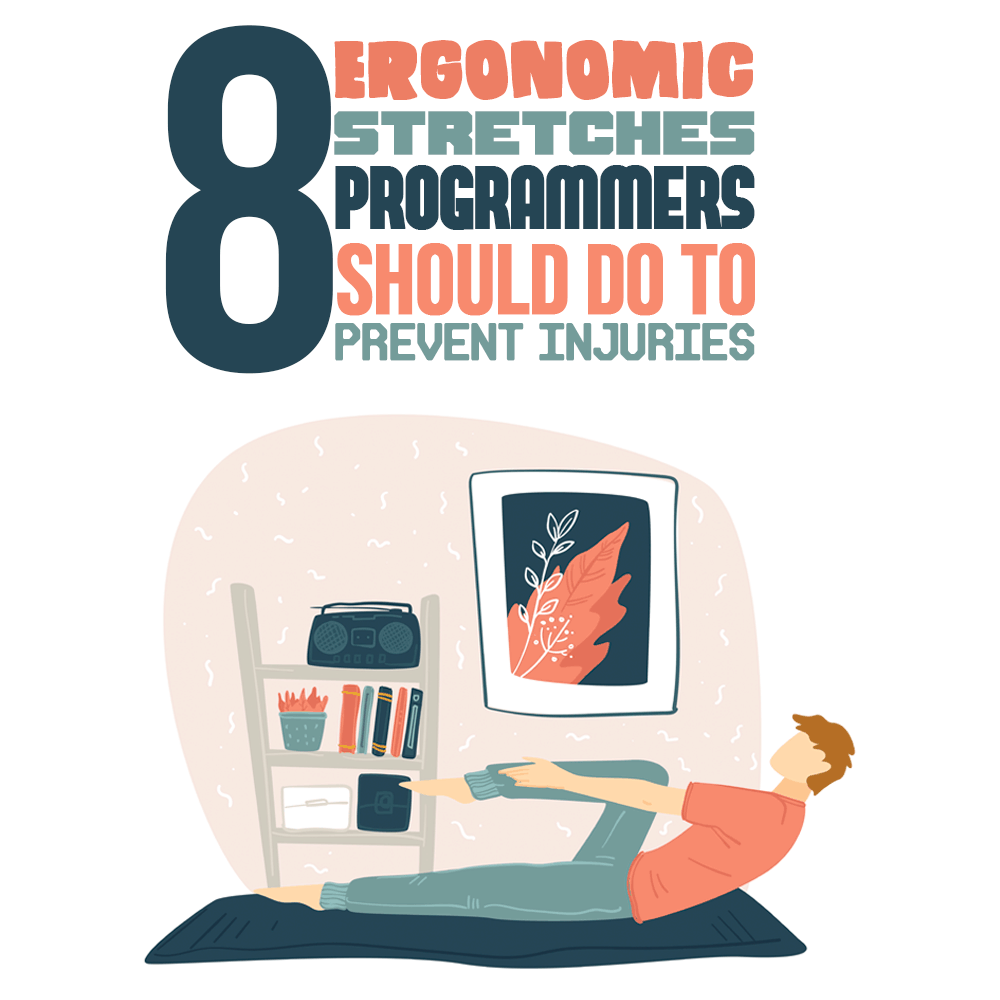 Programming is one of the most rewarding yet potentially hazardous professions out there. I should know; I used to be a programmer before assuming my current role as an ergonomic consultant.
Programming is one of the most rewarding yet potentially hazardous professions out there. I should know; I used to be a programmer before assuming my current role as an ergonomic consultant.
Time just flies as you’re tackling one “riddle” after the next until all the pieces of the puzzle come together. Before you know it, you’ve been staring at a computer for 10 hours already. And while it rarely feels that long, your body is registering every grueling second of it.
It’s no surprise that, according to statistics, up to one in four workers in a computer-centric job suffers from some type of RSI (repetitive strain injury) such as carpal tunnel syndrome and back pain. In the book “The Healthy Programmer,” author Joe Kutner cites RSI as the biggest threat to programmers’ careers.
Apart from taking regular breaks, one of the most effective ways to keep RSI at bay is to frequently engage the overused or stagnant muscles in a way that balances and strengthens the surrounding tissues. And for that, nothing is better than periodic stretching.
In this post I’ll share eight of the best stretches programmers—and computer users at large—can practice to reduce their chances of injuries and improve their productivity at the same time.
Hand and Wrist Exercises
For programmers, the hands and wrists are on the front line of stress bearing, as they craft every letter of a Python function or JavaScript loop. Due to this fact, it’s especially important to rest and stretch those body parts periodically.
According to a study involving 92 patients, exercise was found to provide significant relief for wrist-related RSI such as carpal tunnel syndrome.
Here are two hand stretches I always tell my desk-bound clients to practice at work at least twice daily, but you can do them whenever you start to feel discomfort in your fingers or wrists. The key is to listen to your body.
Basic Wrist Stretch
The basic wrist stretch is the easiest way to rebalance your wrist’s range of motion after typing for a long time.

- Extend your arm out in front of you with the palm facing the ceiling.
- Using your free hand, gently pull the fingers on the extended arm back toward your body until you feel a stretch. Maintain this position for at least five seconds.
- Repeat this exercise from scratch, performing it on your other hand.
- Do three to four sets of the basic wrist stretch.
Wrist Circles
This exercise is one of my favorites to rejuvenate the entire wrist. To perform the wrist circle, do the following:
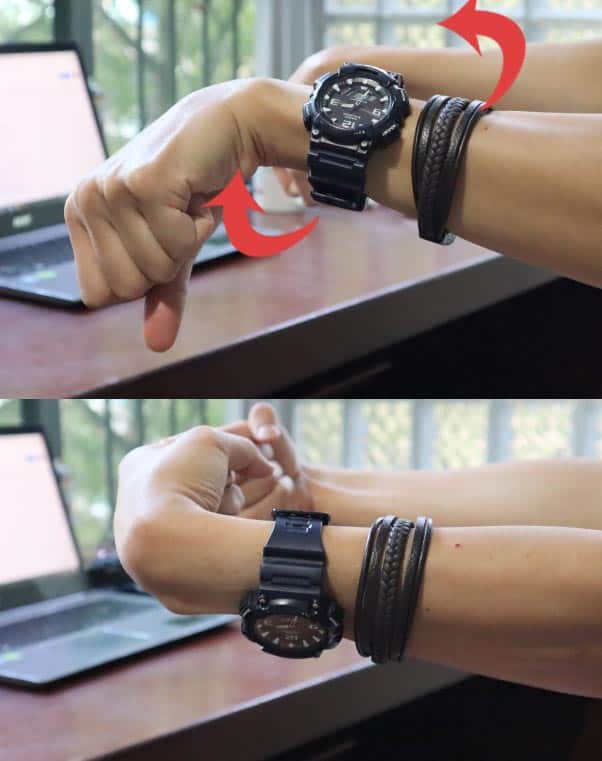
- Extend both arms straight in front of you.
- Make a fist with both of your hands.
- Rotate your right wrist clockwise and your left wrist in the opposite direction as you make circles with your wrist. Do this motion for three to four circles.
- Now alternate the direction (counterclockwise for right wrist, clockwise for left) for another three to four circles.
Neck and Shoulder Stretches
As a programmer, it’s probably not uncommon for you to experience pinching in the neck or tight shoulders after a long coding session. Research backs up the high prevalence of these complaints, which shows that up to 45.5% of office workers experience neck pain.
There are many reasons for experiencing neck pain when coding, but the main factor is the prolonged staring down at a laptop screen. The downward angle puts tremendous strain on the cervical spine (neck region), negatively affecting both the neck and shoulders.
Here are two great stretches to take up for the neck and shoulders.
Levator Scapulae Stretch
Levator scapulae muscles are those that connect the base of your neck to the shoulders; there’s one on each side of your neck. If you’re experiencing pain or stiffness in this region, doing the levator scapulae stretch can really help. It can be performed in a standing or sitting position. Here’s how to do the seated version:
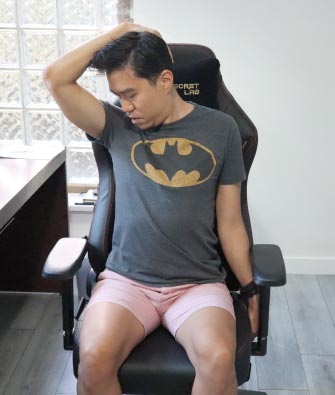
- Sit up straight at your desk with hands to your sides.
- Straighten your left hand to hold on to the bottom of your seat and open up your chest.
- Turn your head to the right and turn your gaze toward your armpit or right pocket.
- Bring your left hand over your head and clasp the back of your head. Gently press down to bring your head closer to your armpit.
- Feel a stretch at the back of your cervical spine as you hold this position for five seconds.
- Repeat the stretch on the other side.
Bent Arm Shoulder Stretch
This exercise is one of the best stretches to ease a tense shoulder and bring some blood circulation back to it. I’m talking about the bent arm shoulder stretch:
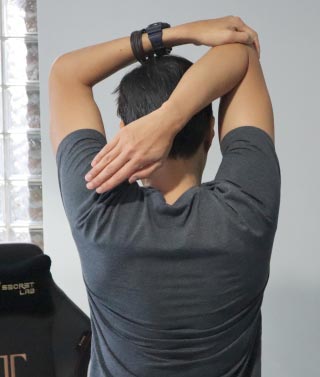
- Start in a standing position with your feet hip-width apart.
- Bring your right arm over your head, then bend it at the point of the elbow toward the left side.
- Using your left hand, grab the right elbow and pull it toward your left shoulder.
- Hold this position for about 30 seconds then repeat the exercise on the opposite side.
Back Stretches
Here’s a sobering fact that all programmers should know: Back pain is the single leading cause of disability worldwide according to the American Chiropractic Association. In fact, back pain was what prompted me to switch professions after 10-plus years as a programmer.
An important part of keeping back pain at bay is to frequently engage that area to strengthen the muscles and bring some much-needed blood circulation. Here are two back stretches that will do just that.
Downward Facing Dog Stretch
When it comes to back pain, yoga is mentioned in many literature as an effective way to combat and even cure back pain. One of my favorite books on the subject is “Yoga for Back Pain” by Loren Fishman.
Every yoga enthusiast knows about the famous downward facing dog stretch, but did you know this exercise can be performed sitting down as well? How’s how:

- Begin by sitting in your chair with your back straight.
- Raise your hands upward toward the ceiling with the palms facing away from you.
- Gradually bend forward at the waist until your hands and forearms are flat on the desk in front of you. Make sure to maintain a straight back throughout the process.
- Keep your neck engaged so it doesn’t flop down. Maintain this posture for 10 seconds before slowly coming back up.
Spinal Twist
This exercise not only helps to relieve pain in your lower back, but also promotes spinal mobility and good digestion. Follow these steps:
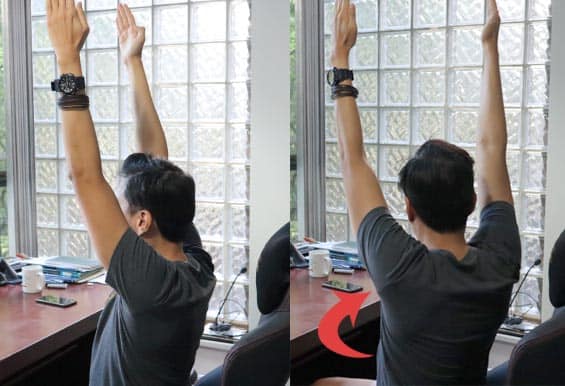
- While sitting on a chair, raise your arms upward so that your palms are facing each other.
- Rotate your upper body to the right as far as you can while keeping your arms up in the air.
- (Optional) As you breathe out, lower your arms, bringing them to the same height as your shoulders.
- Resume your starting position and perform on the other side. You can do up to five sets, alternating each side.
Leg Stretches
Sitting for long periods can also take a toll on your legs. Such prolonged sitting causes blood to pool in your legs, exerting unnecessary pressure in your veins and causing pain and numbness.
In fact, sitting for too long can cause varicose veins, a condition that affects over 30 million Americans. To avoid this unpleasant condition, it’s crucial that you get up and stretch out your legs often.
Perform these stretches to relieve pain and numbness in your legs and feet.
Hamstring Reach
This exercise is great for loosening up the hamstring muscles and releasing the pressure underneath your thighs after prolonged sitting.
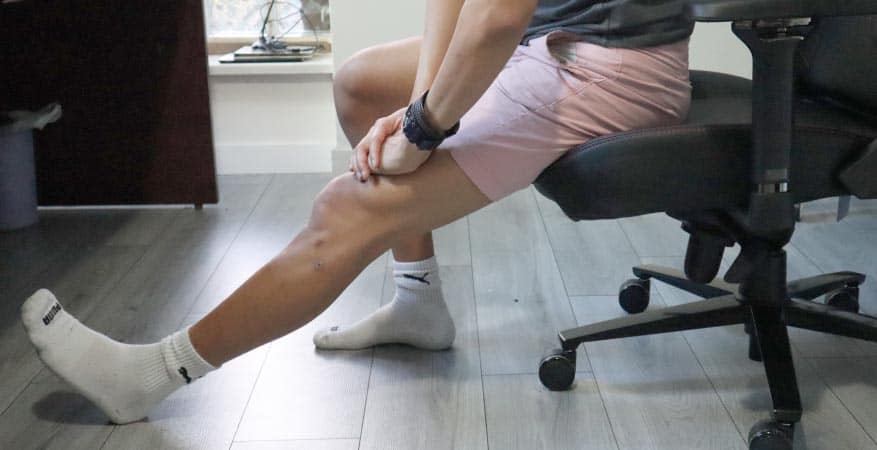
- Sit close to the edge of your seat with your two feet flat on the floor.
- Extend your left leg in front of you with your knees as straight as your flexibility permits.
- Gradually reach forward by bending at the waist. Use your arms to gently push down on your left thighs or knees to further straighten the active leg. Keep your back and spine straight.
- Maintain this forward position for a minimum of 10 seconds. Repeat the process from scratch three more times before performing it on your left side as well.
Calf Raises
The calf raise is an accessible routine that effectively stretches your calf muscles. I do it once a day behind my office chair.

- Begin in a standing position. You can stand behind your desk or chair, but ensure you have something to hold on to for support
- Raise your heels as high as possible using all five toes for stability.
- Gradually lower yourself down, bringing your heels to touch the floor again.
- Aim for three sets of 10 calf raises to ensure you fully stretch your legs.
A Simple but Effective Solution
It’s very easy to get lost in your work as a programmer. It’s a double-edged sword that brings tremendous satisfaction on the one hand, and yet on the other, a potentially heavy toll on your mental and physical health.
Stretching is one of the simplest yet most effective solutions for counteracting a lot of the negative effects of working in front of a computer for long hours daily. The key is consistency: Strive to stretch your body at least twice a day, and get up and move about once an hour minimum.
I think that in just a few days you’ll not only feel better physically, but also notice an improvement in your ability to focus and get work done faster. It’s done this for me.
